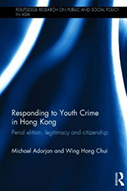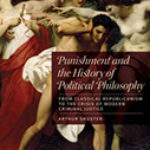Responding to Youth Crime in Hong Kong: Penal Elitism, Legitimacy and Citizenship

Author: Michael Adorjan and Wing-Hong Chiu
Publisher: London; New York: Routledge, 2014. 178p.
Reviewer: Leona Lee | January 2016
Recent decades witnessed a seismic shift in criminal justice philosophy from rehabilitation to retribution and incapacitation in many western countries. Dire warnings of imminent crime waves to be fed by exponential births of super predators; sensational journalism that dwelled on the most heinous young criminals aroused intense public fear. They inspired politicians to enact draconian sentencing policies that led to mass incarceration and swelled the ranks of law enforcement. Extreme sentences frayed the fabric of poor and minority communities; their astronomical costs weighed heavily on state budgets. Today, politicians from both sides of the political spectrum contemplate sentencing reform to cut costs. In view of the painful consequences of extreme punitiveness, what led society to be so vindictive? Was it inevitable?
Michael Adorjan and Wing-Hong Chui have here laid out an alternative approach to that punitiveness, although they are not necessarily comparing criminal justice systems nor being critical of the West. They are, however, critical of most criminological theories. The authors lament that most of these theories are relevant to western countries only, and indeed, research results from Hong Kong contradict the basic tenets of some major criminological theories. For instance, rather than causing delinquency, the strain described in strain theory has actually seemed to hold back crime. According to Adorjan and Chui, Asian countries are not merely exotic outliers that deviate from the western norm. They argue that despite globalization, Asian countries remain geopolitically dissimilar from the West.
Analyzing the HK juvenile justice system, the authors describe how the rehabilitation modelsurvived important historical changes, from the 1960s to the present. They barely mention the western system. But to readers from the West, there are striking similarities and differences. Like the West, crime rates in HK were rising in the 1970s. There were riots in the 60s, some with political motives. While the West was suffering from severe recession, HK’s soaring economy provided abundant funding to expand social and corrections programs. Unlike most western countries where corrections is closely linked with law enforcement, the HK Correctional Services Department collaborates with the Social Welfare Department. The government regularly seeks the opinions of social workers when formulating corrections and penal policies, and punishment is viewed from a welfare and rehabilitation perspective. Nevertheless, HK’s crime rates have remained low.
In Responding to Youth Crime in HK, Adorjan and Chiu do not glorify HK’s successful corrections system, but rather mourn the lack of democratic processes in the former British colony. Their ultimate goal is to expose and criticize the governance system in HK. Thus, their analysis of juvenile justice policies is for illustration purposes only.
To readers unfamiliar with HK’s historical background, the city appears as a westernized, cosmopolitan city steeped in its British colonial legacy; a Chinese Special Administrative Region moving towards a complete merger with China, but enjoying rights and freedoms banned there. Yet despite its status as a global city with the sixth largest stock market in the world, and its westernized lifestyle where English is an official language, Hong Kong is different from the West, especially in its political structure.
Adorjan and Chui’s main thesis is that: due to the lack of democratic processes, juvenile justice policies are a vehicle used by the government to defend the constant challenges to its sovereignty rights. Rather than relying on research or public opinion, strategies against youth crime are shaped by extraneous factors, such as preserving the city’s global reputation and the status quo. For example, to quell the anger of young rioters in the late 1960s, the government created programs aimed at strengthening their identification with Hong Kong, rather than with China. The changes in the minimum age of criminal responsibility, the rush to assume teenage sex offenders are capable of criminal intent, and the reluctance to expand restorative justice are all politically calculated moves to enhance the status of a government nervous about its legitimacy. This was the way both during colonial times and thereafter.
For those curious about colonial governance, the authors provide intricate details. Examples throughout the book illustrate how, without any democratic spirit and amid constant challenges to its legitimacy, absolute government control is masked by a veneer of manipulated public opinion disguised as the public’s will. Advocates for democracy might find it appalling. But the colonial government was actually quite successful at what it was doing. At the end of their lease, the British handed over a former colony that was politically stable and economically prosperous. Many in HK were sorry to see them leave.
According to Adorjan and Chui, Hong Kong operates within a system of penal elitism; a small circle of elites controls all decision-making. In some respects, this is similar to the liberal elitism experienced in post-war England, which became increasingly democratic. Penal elitism in HK, however, proves to be timeless — continuing beyond the colonial era. That is why the rehabilitation model survives; because it works for those in control, according to Adorian and Chiu. It is prudent to play it safe and to maintain the status quo, lest changes disturb the equilibrium and create unwanted consequences. Unlike in England, in HK there were never even fleeting thoughts about heeding the public’s desire for change.
While these authors pine for democracy in Hong Kong, they blame democracy for the extreme penal policies in the West, especially in the United States. To elaborate, in a system of democracy or penal populism, politicians are held accountable by their constituents. To win public support, they often draw attention to problems in society, real or exaggerated, and promise to provide needed solutions. In the United States, proposals for extreme retribution emerged amid rising crime rates in the 70s; their justification was enhanced by the media’s constant updates of grisly crimes. Draconian sentencing policies were an ideal platform for politicians. Harsh punishments were deterrents, and secured justice and retribution. That the typical recipient was some young minority male from an inner-city ghetto far from middle-class neighborhoods, made such measures palatable. At each election, there was intense pressure to increase drastic measures while calling opponents soft on crime. Opinions were manipulated to support draconian policies. Conversely, Adorjan and Chui attribute the lack of severe sentences in HK to the lack of minority-filled ghettos or the need for politicians to heed the public’s opinions. But juvenile justice policies in HK were in fact manipulated for other purposes.
The authors cite a few examples of this. For instance, debates about increasing the minimum age of criminal responsibility (from seven to ten) began in the 70s, but changes were not made until 2003 — six years after China took over. The catalyst was the need to show the world that HK was not being squashed by communist China and was adhering to international standards. HK’s global image was of paramount importance. In the wake of the Tiananmen Square massacre, China still evoked dreadful feelings in international circles. Interestingly, proposals to further increase the age of criminal responsibility to 14 were dismissed as not in sync with other Asian countries. Adherence to international standards was apparently a flexible bargaining chip, providing justification for or against changes as seen fit by those in power.
An argument against increasing the minimum age of criminal responsibility to ten was that retaining a low minimum age protected children from exploitation by older criminal elements. This convoluted logic was that older criminals would think twice about using children as accomplices if kids could get a criminal record and sentence. Likewise, kids would think twice before abetting a crime if they could face prosecution. The government’s ability to control older criminals seemed to hinge on the threat of criminalizing young children.
The reluctance to expand restorative justice likewise illustrates the geopolitics of HK. Restorative justice aims at reintegrating criminals, especially young offenders, back into society, and involves active victim participation. Opponents in HK, however, are especially concerned about the virtues or center pieces of restorative justice — the community-based and informal process. These two elements stirred up intense fear of mainlandization, an apprehension unique among HK citizens. They hate the notion that HK might increasingly take after China, the mainland, where individuals have limited due process rights and innocent people got entangled in the system via informal and arbitrary processes. That restorative justice involves victim participation is also a drawback; victims might lose face and be intimidated by the offender.
The substance of this book is linked to political science and juvenile justice. It is a good read for those interested in learning about a juvenile justice system that did not subscribe to severe punishment or retribution and where the lack of democratic processes actually preserved the rehabilitation ideal. In their zeal to criticize colonial rule, Adorjan and Chui seem to have overlooked some of the successful work and beneficial programs created by the previous British government. At a minimum, it never abandoned the rehabilitation ideal for most delinquents. Given that democratic processes in the United States led to enacting cruel sentences and punishment, maybe the authors should be glad that HK did not follow suit. But their sentiments are understandable. Maybe it is not worth it, if the price is democratic freedom.
This book is a must read for those interested in learning about colonial governance. The authors demonstrate good scholarship, laying out in great detail the historical development and operations of the British colonial government. They use multiple sources of information to make a convincing case, overwhelmingly supporting their analysis with facts rather than mere opinions. In addition to thorough explorations of decades of Government Annual Reports, official and unofficial documents, and Legislative Council meetings minutes, there were interviews with dozens of professionals who played various roles in the juvenile justice system in HK in the past half century. For criminal justice scholars interested in cross-cultural studies of juvenile justice systems, Responding to Youth Crime in HK is worth careful consideration.


